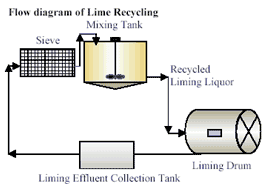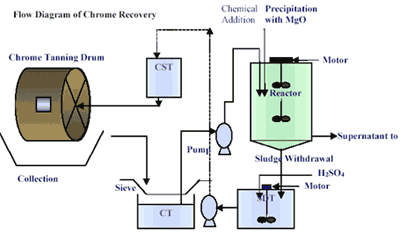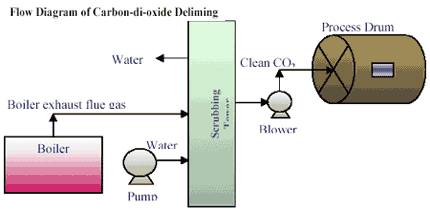CTP-KT
Water Conservation
About 29-55 cubic meter of water is used for the production of 1 tone of wet-salted raw goat skin/hide and 90 to 210 cubic meter per tone of sheepskin.
Measurement and control of consumption are an important and essential point of the water conservation.
The current practice in Korangi tanneries is that water is being used without any measurements, continuous washing of drums,
ignorance of water leakages and use of high-pressure pipes for floor washing and personal use.
Unnecessary high amounts of water consumption in process that also increases the electricity consumption.
Water has to manage properly and several options are available to minimize the overall consumption of water.
1. Install flow meters (Flow meter with flexible pipe, Pneumatic control valve, Aqua mix system) on every intake line of process drums and inlets & outlets of pipeline.
2. Replace continuous washing practice with batch washing.
3. Optimize the batch washing practice i.e. use correct quantity of water for washing.
4.After adaptation of water conservation each tannery can save around 5 lacs to 15 lacs/year according to their production.
5.Floor washing should be done with controlled water discharge. Using floor wipers, Vigilant and regular monitoring over water leakages and installation of separate washbasins for worker can reduce excessive use of water.
Water conservation is important as it not only reduces the cost of water and electricity used but will also minimize the treatment cost of wastewater. As the Korangi tanneries are connected to Combined Effluent Treatment Plant (CETP) and also sharing the operation and maintenance cost of the said plant. As per the agreed formula of CETP O&M cost sharing, Rs. 7.5 cubic meter of wastewater is to be paid. The contribution of cost will be based on the quantity of wastewater discharge from each tannery.
Lime Recycling
The current practice in Korangi tanneries are that the spent liming liquor is drained out which contributes about 30 to 40% of overall pollution load.
Direct recycling of the liming float is possible after removal of suspended solids.
Chemical contents of the float are restored using fresh lime and sulfide to its initial composition before reuse in another liming process.
Resulting advantages are savings in sodium sulphide (up to 40%) and in lime (up to 50%).

Chrome Recovery and Recycling
It is observed that 25-30% of applied chrome remains unconsumed and drained out as effluent. Adoption of chrome recovery in case of rawhide to finished processes practiced by some of the tanneries.
It is possible that 90-95% of unconsumed chrome can be recycled. It comprises of collection of spent chrome liquor after basification and recovery of chrome from the same.
Savings can be obtained from the process, by a reduction of 20% of the chromium used and substantial reduction in the amount of salt used

Carbon Di Oxide De-liming
In most tanneries, Deliming is done by traditionally with Ammonium Sulfate. Ammonium sulfate generates fugitive emission of ammonia.
It is considered that up to 40% of ammonical nitrogen is produced by the use of ammonium salts during the deliming process.
The use of Carbon dioxide can be considered as a cleaner technology giving good results. This option reduced the consumption of Ammonium Sulfate.
Emission from boiler can be use for this purpose. Resulting advantages are Ammonia free environment in tannery as well as reduction in nitrogen concentration in wastewater and by which also improve the leather quality.

Salt De-dusting
Natural salt applied for the preservation of skins can be recovered by manual dry dedusting, mechanical brushes or using a sieve drum type shaker to eliminate up to 15-18% of the salt added to hides and skins for preservation.
However, salt must be recovered before soaking the skin to control the chloride contents in the final effluent.High chloride concentration is toxic to biological wastewater treatment system and increases salinity of natural water bodies.
Benefits
1.Approximately 10% to 12% reduction in soaking and liming chemicals.
2.Quality of leather will be improved by using optimum dosage of chemicals.
3.Effective batch washings due to effective De-dusting.
4.Reduces Pre-soak time.
5.Less quantity of Chloride in the effluent that reduces the pollution load, i.e., reduction in the cost of end of pipe treatment plant.
6.Contamination of soil is avoided
Usage of De-Dusted Salt in Pickling Process (If Chrome Recycling in Progress)
Tanneries use large quantity of salt in the pickling process, wherein the salt is dissolved in water along with other chemicals for reducing the pH of the pickle.
The salt used is in the range of 7 – 10% of the weight of skin. The de-dusted salt cannot be used in the pickling process due to the presence of physical and bacterial contamination in it.
Therefore tanneries have to purchase large quantity of superior quality salt for use in the pickling process.
The de- dusted salt after dissolution in water can be passed through a sand filter for the removal of physical and bacterial contaminations.
The filtered salt water can be used in the pickling process of the tannery thus saving the cost of the purchase of salt, as well as environmental problem of damping of salt will also be solved.
Resulting advantages are saving of salts use in pickling process along with a good solution of solid waste disposal.
Proper Raw Trimming
Through optimization of raw trimming by trained and skilled labor obtain the following benefits
1. Reduction in the hide's weight saves the chemical input in the proceeding processes.
2. Rawhide’s trimmings can be sold easily to manufacturers of poultry feed, adhesives and soap.
3.Improvement in the selection of the hide/skin.
4.Facilitates mechanical operations, e.g., Fleshing, Splitting & Shaving.
5. Decrease of processed solid waste amount that reduces pollution at source.
Green Fleshing
1.Produces better fleshing without lime contamination, which improve marketing possibilities.
2.Green fleshing is utilized in poultry feeds and in gelatin manufacturing.
3.Soaking and liming time will be reduced.
4.Water is absorbed more readily from the flesh side while the epidermal layer rendering the grain side much more resistant.
5. Speeds up the water uptake of the hide reduce the chance of putrefaction.
6.Produces better penetration for the chemicals.
7.Flattens and stretches the hide has a pronounced cleaning action produced by fleshing machine.
8.Decrease of limed solid waste amount.
9.Reduces pollution load in the effluent due to less chemical consumption in the Soaking and liming processes.
Lime Splitting
1. Chemical savings for Deliming, Bating, Pickling and Tanning processes.
2.Chemical Cost Reduction, i.e., 37% per ton of Pelt Weight.
3.By products can be processed separately with recycled effluent.
4.The trimmings of this type of split, i.e., the solid waste could be used in poultry feeds or for gelatin manufacturing.
5.Area Gain will be more.
6.Reduces the time for Deliming, Bating, Pickling and Tanning processes.
7.Produces better penetration for the chemicals.
Reduction at Source
A.Technology change
1.Carbon-di-oxide De-liming
B.Input Material Change
1.Use of enzymatic products instead of sulphides.
2.Use of biodegradable surfactants.
3.Avoid penta chloro phenol.
4.Use of weak organic acids instead of ammonium sulphate.
5. Use water finishers instead of halogen hydrocarbons.
C.Good Housekeeping
1.Use of wooden pallets for raw hide/skin or wet blue.
2.Use of wipers for extra floor washing.
3.Use low-pressure pipes or install nozzles on high-pressure pipes for floor washing.
4.Provide washbasins for workers.
5.Provide proper light and ventilation in processing hall and stores.
6.Control water leakages.
7.Construct separate drains for liming and tanning operations.
8.Construct covered and sufficiently sloped drains.
9.Raw skins/hides and wet blue stack on wooden pellets.
10.Well-maintained floors with proper slope.
11. Sufficient provision of light and ventilatio